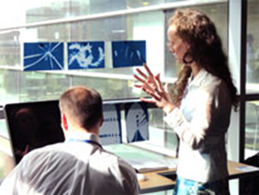Symposium celebrates students’ creativity, research
From projects that peer into the brain and the heavens to machines that race on the desert floor and transform recyclables into products, student research took center stage Friday at the Anschutz Medical Campus.
The 15th Annual Research and Creative Activities Symposium (RaCAS) featured 110 student research projects across disciplines at the University of Colorado Denver | Anschutz Medical Campus. Undergraduate and graduate students presented projects that, in many cases, took at least two years to complete.
Mary Coussons-Read, associate vice chancellor for research and member of the symposium planning committee, said the event celebrates the learning and research of the university's students.
"It gives students the opportunity to talk about their work," she said. "We want them to develop a community with other students."
The symposium included a keynote address by Adam Lerner, director and chief animator of the Museum of Contemporary Art in Denver, an awards ceremony and -- new this year -- a panel discussion on "Innovation and Creativity."
Four projects were selected Outstanding Research and Creative Activity Award Winners, giving the students the chance to present their research to the entire symposium. The winners and their disciplines were:
- Lydia Hooper, environmental media, College of Liberal Arts and Sciences
- Dayton Goodell, psychology, College of Liberal Arts and Sciences
- Jennifer Chipman, civil engineering, College of Engineering & Applied Science
- Rebecca Green, reproductive sciences, School of Dental Medicine
Hooper's project, "Life at La Suerte: Visualizing Human Relationship with Rainforest Biodiversity," involved creating an educational website, www.skawak.org, about rainforest biodiversity.
"I don't want it to all be gloom and doom," said Hooper, who studied rainforests in Costa Rica. "I have a lot of stuff on there about what we can do to help (rainforests) as well."
Goodell's project is titled "Effects of Adolescent Social Deprivation on Social Reward: Ethanol Preference and Social Abuse Escape Behavior." His project examined drugs of abuse and social reward and the interaction between the two.
"We know that in human early life adversity results in psychological disorders later in life," said Goodell, who used rats in his study. "...We wanted to know what's going on in the brains during these behaviors."
Chipman traveled to New Zealand to complete her project, "The Value of International Collaborations in Understanding How Climate Change Affects Water Supplies from Snow Dominated Catchments."
Conducting research in Colorado and New Zealand, her project studied climatological patterns -- such as snowfall and water levels -- and infrastructure designs -- such as pipelines and water treatment plants -- and the relationships between the two.
"I'm interested in how we harness that water supply ... and then how will climate change effect the design of all that infrastructure," Chipman said.
Green's award-winning project is titled "Development of the Cleft Lip/Palate -- Establishing a Role for Shape."
Other sets of awards -- the Chancellor's Awards, Outstanding Student Mentor and the UROP Awards -- were presented later in the day.



